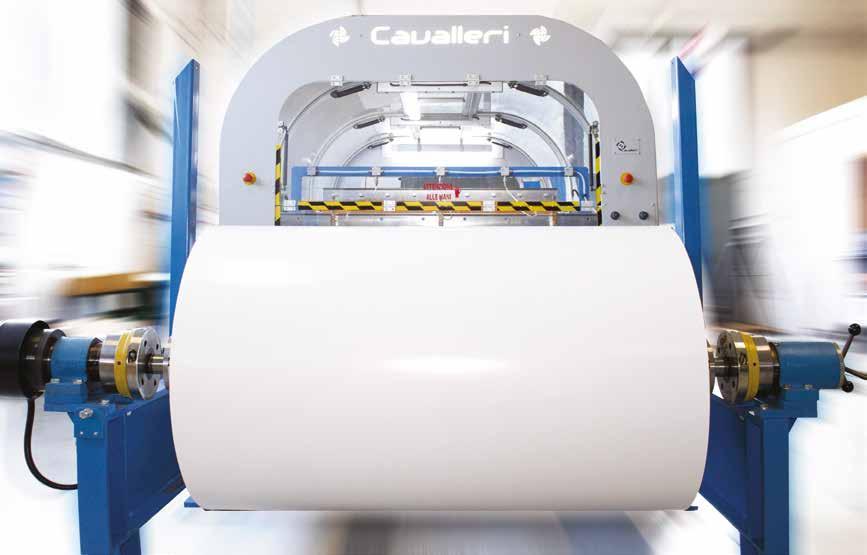
16 minute read
VETAPHONE: STORIE DI SUCCESSO
Il laboratorio prove di Vetaphone può eseguire prove su fogli e bobine con tecnologia Corona e al plasma / The Vetaphone Test Lab facility can test substrates in sheet or roll form with both corona and plasma surface treatment technology produzione del cliente. Questa è una recente aggiunta alla prove eseguite in laboratorio e “dal momento che possiamo eseguire sia test Corona che plasma, possiamo diventare un vero partner dei nostri clienti. Questo è ancora un processo nuovo per me, ma sempre più clienti sono interessati a testare bobine intere e sono presenti in laboratorio per assistere allo svolgimento dei test. Questo è davvero entusiasmante perché imparo nuovi modi di utilizzare l’attrezzatura per le prove”, afferma Huifang. Quando il laboratorio esegue i test al plasma come prova di fattibilità, il cliente invia i materiali e viene creata quella che Vetaphone chiama “la curva dei materiali”, che viene rispedita al cliente con diverse ricette. Il cliente valuta i campioni trattati e trova quale ricetta funziona meglio per loro. A causa della complessità e dei costi aggiuntivi, Vetaphone lavora a stretto contatto con il reparto R&S del cliente per la verniciatura al plasma e il collaudo. È uno strumento molto preciso ed è regolabile per ottenere il risultato desiderato.
Nick ha chiesto a Huifang qual è la parte più affascinan- the sons of the founder, and that began my journey with Vetaphone, initially as a student helping with material testing, and sales support for the Asian market”.
Advertisement
Working At Vetaphone Laboratory In Kolding
Now Huifang’s job as Senior Lab Technician revolves around the testing of plastic film and foil materials and substrates for their adhesive abilities with the liquid inks and lacquers that are applied. Essentially at laboratory they find out if the substrate does what it needs to do in a commercial environment. The unique Test Lab facility allows to verify the desired dyne value for each material, measuring the surface tension with a dyne pen or the contact angle, and sometimes the peel strength, depending on what’s needed. “When it comes to corona testing, it is more about ensuring we offer the right corona power solution and support our customers. The customer sends us his/ her materials and we corona treat them in our Test Lab and measure each power dosage. Then, we send them a detailed report of the test results so they can find the optimal corona treatment for their production lines”, explains Huifang.
For Customers Is Very Important To Test Materials
As far as most converters are concerned, PE is PE, and PP is PP, and that’s that - until something goes wrong in their process they blame the corona treater! “One of the first things you learn from testing materials is that no two rolls of film are identical. We often end up showing them that the same material from different suppliers needs a different power density to reach the dyne level needed for the next process. All materials react differently – even when they are supposed to be the same, so we can only offer the right solution if we get to test the materials”.
As regards tests there are basically two types of tests performed in the lab: sheet tests and roll tests. With sheet tests, are use smaller batches of material that allows to provide customers with quick answers and in many years of experience Vetaphone gained valuable knowledge on different substrates.
With roll to roll, the lab tests a full roll of the material with several different recipes that can be further tested on the customer’s own production equipment. This is a recent addition to Test Lab capability, and “since we can te del suo lavoro e la sua risposta è stata molto chiara: “ottenere un risultato! Sono molto più soddisfatta quando i test che svolgiamo aiutano i nostri clienti. Il processo di prova deve essere metodico e accurato senza margine di errore, quindi richiede molta concentrazione. Ma è interessante scoprire perché e come il lavoro che svolgo fornisce ai clienti le risposte di cui hanno bisogno e perché un particolare supporto è un problema per il cliente o necessita di un trattamento Corona più intenso. È un po’ come un medico che cerca di capire cosa fa ammalare un paziente, è un processo di eliminazione”.
Huifang si sente davvero parte della famiglia Vetaphone: non dobbiamo dimenticare che è molto lontana da casa e vive e lavora in una cultura e in un ambiente molto diversi. “Adoro il modo in cui lavoriamo in squadra: mi dà un senso di orgoglio per quello che faccio e un sentimento di appartenenza, che è molto rassicurante. Ci aiutiamo tutti a vicenda e abbiamo lo stesso obiettivo: clienti soddisfatti!”, conclude. run both corona and plasma tests, it allows us to become a much closer working partner with our customers. I must say that this is still a new process to me, but more and more customers are interested in testing entire rolls, and join us in the Lab to watch the tests take place. This is really exciting because I get to learn new ways of using the test equipment”, says Huifang.
When the laboratory carries out plasma testing as proof of concept, the customer sends materials and is created what Vetaphone calls ‘the material curve’, which is sent back to the customer with different recipes. The customer evaluates the treated samples and finds which recipe works the best in their process. Because of its complexity and additional cost, Vetaphone works much closer with customer’s R&D department on plasma coating and testing. It’s a very precise tool and is tuneable to achieve the desired result.
Then Nick asked what is the most fascina- ting part of Huifang’s job and her answer was very clear: “getting a result! I feel most fulfilled when the tests we carry out help our customers. The testing process itself must be methodical and accurate with no margin for error, so it requires a lot of concentration. But it’s interesting to find out why and how the work I do provides the customers with the answers they need and why a particular substrate troubles the customer or needs high corona power.
It’s a bit like a doctor investigating the root cause of what is making a patient sick, it’s a process of elimination”.
Huifang feels very much part of Vetaphone family: we must not forget that she is a long way from home and living and working in a very different culture and environment. “I love the way we work as a team – it gives me a sense of pride in what I do, and a feeling of belonging, which is very comforting. We all help each other and have the same goal – happy customers!”, she concludes.
UPM Specialty Papers e Henkel creano un imballaggio termosaldabile sostenibile resistente ai grassi
Lavorando a stretto contatto con i partner di tutta la catena del valore dell’imballaggio alimentare, UPM Specialty Papers sta sviluppando soluzioni in partnership con altre aziende leader che reinventano il futuro dell’imballaggio sostenibile. Una relazione di lunga data con Henkel ha dato vita a un materiale di imballaggio riciclabile e termosaldabile compatibile con le linee di imballaggio esistenti. Portando le prestazioni delle carte barriera a un livello insuperabile di resistenza al grasso, offre una soluzione collaudata per i converter.
“In linea con le nostre ambizioni di sostenibilità per il 2030, le nostre verniciature termosaldanti LOCTITE LIOFOL HS 2809-22 RE a base acqua e quelle antigrasso AQUENCE
EPIX BC 6134 sono facili da riciclare, per recuperare più fibre e sostenere un’economia più circolare. Insieme a UPM Specialty Papers, abbiamo compiuto un ulteriore passo in avanti per colmare il divario tra imballaggi sostenibili a base di fibre e imballaggi in plastica tradizionali per supportare i proprietari di marchi e i trasformatori nel passaggio alla carta”, afferma Christin Noack, Market Strategy Manager Paper Solutions di Henkel.
Le carte barriera UPM Asendo™ e UPM Asendo™ Pro hanno fornito il punto di partenza. Si tratta di carte barriera riciclabili prodotte con fibre provenienti da foreste gestite in modo sostenibile e offrono resistenza al grasso e all’umidità senza la necessità di un rivestimento in plastica. “I rivestimenti barriera e termosaldanti si comportano in modo diverso sui supporti in carta, quindi trovare la migliore combinazione tra carta, verniciatura e applicazione ottimale può essere complicato”, spiega Christin Noack. “Abbiamo messo a punto le nostre verniciature termosigillanti e con barriera al grasso dopo una serie di prove e un lungo processo di sviluppo. Insieme a UPM, abbiamo sviluppato prodotti innovativi che consentono alla carta di raggiungere livelli di prestazioni di barriera nuovi e ineguagliabili”.
“Questa soluzione dimostra ciò che possiamo ottenere con materiali a base di fibre creati in collaborazione. I converter di imballaggi possono scegliere tra una combinazione di carta e rivestimenti “off-the-shelf” già testata e approvata, trovando rapidamente le soluzioni giuste per il loro utilizzo finale. Per i brand owner, rappresenta l’ennesimo prodotto co-creato volto a sostenere la transizione dai materiali a base fossile a imballaggi rinnovabili e riciclabili”, afferma Mika Uusikartano, Senior Manager, Product Portfolio Management presso UPM Specialty Papers.
Mondi aumenta la capacità della carta funzionale con effetto barriera
Mondi sta investendo in tecnologie innovative per aumentare la capacità della carta funzionale con effetto barriera.
UPM Specialty Papers and Henkel create a sustainable heat-sealable packaging concept delivering unrivalled levels of grease resistance
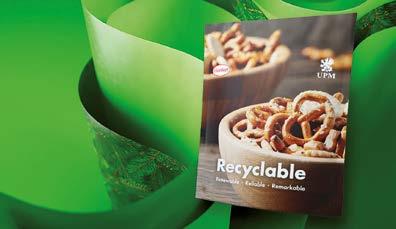
Working closely with partners from across the food packaging value network, UPM Specialty Papers is co-creating solutions that reimagine the future of sustainable packaging. A long-standing relationship with Henkel has now resulted in a recyclable, heat-sealable packaging material compatible with existing packaging lines. Pushing the performance of barrier papers to an unsurpassed level of grease resistance, it offers a tried and tested solution for converters.
“In line with our 2030 sustainability ambitions, our water-based LOCTITE LIOFOL HS 2809-22 RE heat seal and AQUENCE EPIX BC 6134 grease barrier coatings are easy to recycle, helping to recover more fibres and supporting a more circular economy. Together with UPM Specialty Papers, we have moved one step closer to bridging the gap between sustainable fibre-based packaging and traditional plastic packaging to support brand owners and converters in the transition to paper”, says Christin Noack, Market Strategy Manager Paper Solutions at Henkel.
UPM Asendo™ and UPM Asendo™ Pro barrier papers provided the starting point. These recyclable barrier papers are produced with fibres from sustainably managed forests and offer grease and moisture resistance without the need for a plastic coating.
“Barrier and heat seal coatings behave differently on different paper substrates, so finding the best combination of paper substrate, coating, and optimum application can be tricky”, explains Christin Noack. “We fine-tuned our heat seal and grease barrier coatings over a number of trials and a lengthy development process. Together with UPM, we have developed innovative coatings products that enable paper to reach new and unmatched barrier performance levels”.
“This solution demonstrates what we can achieve with co-created fibre-based materials. Packaging converters can select from a ready tested and approved ‘off-the shelf’ combination of paper and coatings, quickly finding the right solutions for their end-use without the need for trial and error. For brand owners, it represents yet another co-created product aimed at supporting the transition from fossil-based materials to renewable, recyclable packaging”, says Mika Uusikartano, Senior Manager, Product Portfolio Management at UPM Specialty Papers.
Mondi increases FunctionalBarrier Paper capacity
Mondi is investing in innovative technologies to increase FunctionalBarrier Paper capacity. Mondi’s range of FunctionalBarrier Paper offers tailored barrier properties that reduce the amount of plastic used in packaging, supporting the development of a circular economy.
BESCO srl nasce nel 1976 e nel corso degli anni, grazie agli stretti rapporti con le più importanti aziende del settore delle macchine da stampa, si specializza nella produzione di carrelli elevatori alzabobine. La costante crescita tecnica ha portato l’azienda a un ampliamento della gamma per consentire l’offerta di prodotti in grado di soddisfare ogni necessità. L’elevata versatilità del processo produttivo consente a BESCO di personalizzare su richiesta i propri modelli per una copertura a 360° delle esigenze dei propri clienti.
BESCO srl was born in 1976 and year by year, thanks to close relations with the most important printing machines’ manufacturers, specialized in reel lift trolleys’ production.
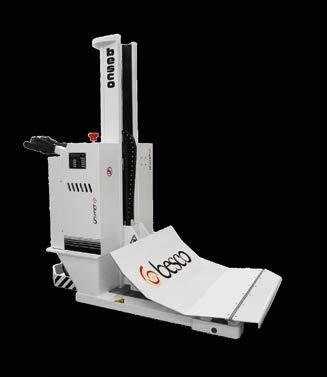
The incessant technical development took the company to an enlargement of his products’ range in order to satisfy any kind of requirements. The great production cycle’s versatility allows BESCO to personalize (when requested) their trolleys to meet all customer’s demands.
CBE 1000/1250/1500
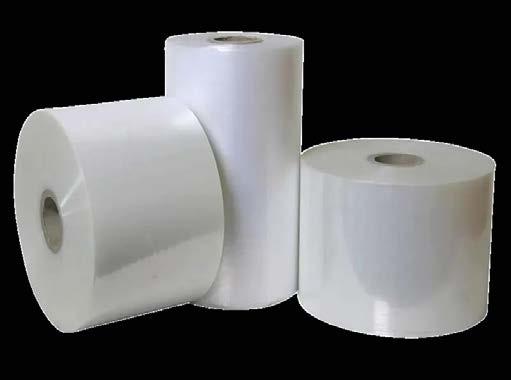
La linea al top della gamma BESCO: carrelli alimentati a batteria. Traslazione e sollevamento elettronico
It is the top line of BESCO production: trolleys feeded with batteries and completely electronics
Carrelli elevatori alzabobine e
per movimentazione interna Reel lift trolley and transporter trucks for internal handling
CB2.10
La linea di carrelli BESCO di semplice uso e manutenzione Traslazione manuale e sollevamento idraulico
It is the BESCO line of easy handling and maintenance. Manual motion and hydraulic lifting
CBM700S
La linea di carrelli completamente manuali Range of manual trolleys
CBE R-1000
La caratteristica principale di questo carrello consiste nel poter caricare / scaricare in maniera autonoma la bobina dal / al suolo, grazie allo speciale braccio con pressore che svolge una duplice funzione: presa e bloccaggio della bobina
CBE2000
Capacità di supportare bobine con peso 2000 kg
Magazzini verticali automatici rotanti portarulli
Il sistema BESCO “CANGURO” sfrutta le altezze del locale, verticalizzando il magazzino e consentendo un risparmio sui costi
Modello Canguro 40/60 con capacità di gestione da 40/60 rulli
La gamma Mondi di carta funzionale con effetto barriera presenta apposite caratteristiche di protezione che riducono la quantità di plastica usata nell’imballaggio, a supporto dello sviluppo di un’economia circolare. La gamma viene supportata dall’investimento in un nuovo estrusore presso la sede di Mondi Coating Štětí (Repubblica Ceca), ma anche dalla costruzione di un edificio desti- nato alla produzione che ospiterà macchinari all’avanguardia come un dispositivo di rivestimento per estrusione e una spianatrice. L’avvio della produzione è atteso per il 2024. Inoltre, un altro investimento è attualmente in corso presso Mondi Jülich (Germania) con il rifacimento dell’esistente dispositivo di rivestimento. Due nuove stazioni di rivestimento per dispersione miglioreranno le caratteristiche di barriera, garantendo una buona copertura sulla base carta. Anche la costruzione di una nuova cucina di patina fa parte del rifacimento e consentirà la pre-copertura della base carta, ampliando così l’offerta per includere più gradi di carta, in particolare il contenuto riciclato. Questi investimenti evidenziano il vantaggio garantito dalla catena di valore integrata di Mondi, dall’approvvigionamento responsabile alla produzione, alla copertura e all’imballaggio, fino al prodotto finale. Mondi investirà e ottimizzerà il suo stabilimento di produzione a Örebro (Svezia), per migliorare ulteriormente la produzione della sua gamma di carta funzionale con effetto barriera, dando così vita a ulteriori posti di lavoro. In sostituzione a film in plastica e laminati, la gamma di carta funzionale con effetto barriera offre alternative di imballaggio a base di fibre, che risultano particolarmente adatte per i beni di largo consumo (FMCG) e che possono essere riciclate nei flussi di riciclo della carta esistenti in tutta Europa. Grazie ai diversi livelli di protezione, la gamma è destinata ad applicazioni industriali ed e-commerce, nonché agli articoli per la cura personale, ai cibi surgelati al confezionamento di cioccolato.

Le buste imbottite EPIX di Henkel ricevono la certificazione internazionale di riciclabilità dall’Istituto cyclos-HTP
Mentre l’ascesa dell’e-commerce continua a ritmo sostenuto, c’è una spinta altrettanto forte per scoprire materiali di imballaggio più sostenibili e riciclabili. Rendendo la carta un’opzione praticabile per la spedizione di materiali, la tecnologia EPIX di Henkel ha rappresentato un importante passo avanti. Oltre a sostituire le buste multi-strato con materiali monomateriali riciclabili,
The range is being supported with an investment in a new extruder at Mondi Coating Štĕtí (Czech Republic). This will comprise the construction of a production building which will house state-of-the-art machinery such as an extrusion coater and a slitting machine.
Production
Is Expected To Start In
2024.
In addition, investment is currently underway at Mondi Jülich (Germany) with the rebuild of an existing coater. Two new dispersion coating stations will improve barrier properties by ensuring good coverage on the base paper. The construction of a new coating kitchen is also part of the rebuild and will enable the pre-coating of base paper and expand the offering to include more paper grades, especially containing recycled content. These investments underpin the advantage of Mondi’s integrated value chain, from responsible sourcing, to production, coating and packaging converting into the final product. Mondi will also be investing in and optimising its Örebro (Sweden) production facility, to further improve production of its FunctionalBarrier Paper range, as well as create additional employment. As a replacement for plastic films and laminates, the FunctionalBarrier Paper range offers fibre-based packaging alternatives that are particularly suitable for fast-moving consumer goods (FMCG) and can be recycled in existing paper waste streams across Europe. With varying barrier levels, the range is tailor made for industrial and eCommerce applications as well as personal care, frozen food and chocolate packaging.
Marko Schuster, COO Functional Paper & Films, Mondi comments: “We are seeing a strong drive in the end markets to reduce the use of plastic and move towards more sustainable paper-based packaging solutions. Our FunctionalBarrier Paper range reflects Mondi’s commitment to this and promotes a circular economy, in line with our MAP2030 goals. We are excited to expand the portfolio and enable our customers to make a smooth transition to more sustainable packaging solutions to meet the growing needs of their consumers”.
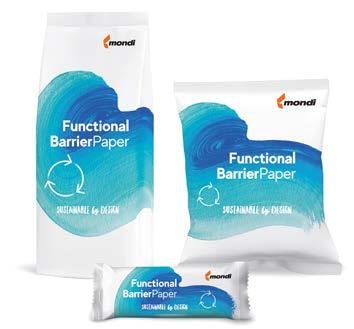
Colorgraf ha realizzato specifici inchiostri e relative vernici di sovrastampa a “basso odore e bassa migrazione” per la stampa di imballaggi primari: le buste imbottite EPIX offrono una maggiore funzionalità, aggiungendo resistenza agli urti senza aumentare il peso dell’imballaggio.
Lithofood Plus, quadricromia offset e inchiostri base “convenzionali”.
Deltafood Plus, quadricromia offset e inchiostri base ad essiccazione UV.

Senolith WB FP, vernici a base acqua da utilizzare “in linea” con gli inchiostri Lithofood Plus.
Senolith UV FP, vernici UV, “basso odore e bassa migrazione”.
L’innovativa soluzione ha ricevuto un’ulteriore certificazione dall’Istituto cyclos-HTP, a conferma della sua compatibilità con i sistemi di smistamento e riciclo nell’UE, Svizzera, Norvegia e Regno Unito.
“La rigorosa valutazione e certificazione dell’Istituto cyclosHTP rafforza le prestazioni e la sostenibilità del concetto del prodotto. Fornisce ai marchi la totale garanzia che questa soluzione è pratica e sostenibile per ridurre al minimo l’impatto delle loro consegne, allineandosi con le opzioni di riciclo locali”, ha spiegato Christin Noack, Market Strategy Manager Europe di Henkel. “Questo prodotto innovativo, caratterizzato da un rivoluzionario materiale di imbottitura leggero al posto delle bolle di plastica, offre prestazioni eccellenti e facilità di imballaggio, con costi di lavorazione ridotti rispetto ad altri tipi di imballaggio. Ad oggi, oltre un miliardo di buste EPIX sono state utilizzate con successo da diverse grandi società di e-commerce per imballare merci online, e questo dimostra l’impatto che la soluzione sta già avendo. L’utilizzo della tecnologia EPIX facilita la riciclabilità della carta e fa parte della strategia di Henkel per arrivare a un’economia circolare”. Il processo di certificazione dell’Istituto cyclos-HTP determina la riciclabilità degli imballaggi in base alla percentuale di materiale riciclabile recuperato (fibre di carta) che è disponibile per la produzione del materiale di partenza (nuova carta).
Film termoretraibile trasparente per etichette avvolgenti
Innovia Films lancia RayoWrap™
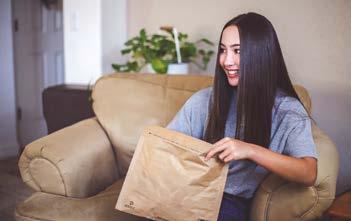
CMS, un film BOPP trasparente per applicazioni di etichette termoretraibili e avvolgenti, stampabile e progettato per fornire una eccezionale grafica a 360° attorno all’intera etichetta. Questo film è perfetto per piccole bottiglie in PP o PE, in quanto può essere facilmente rimosso favorendo il riciclo della bottiglia, oppure l’intero contenitore etichettato può essere riciclato in un flusso di poliolefine. Alasdair McEwen, Product Manager, Labels, spiega “le prestazioni tecniche di CMS30 confermano che funziona in ogni fase della catena del valore, dalla facilità di stampa, all’etichettatura avvolgente con alimentazione a bobina ad alta velocità, fino all’importantissimo riciclo degli imballaggi alla fine della vita utile. Contando soli 30 micron, il film ha anche un’elevata resa, quindi è un modo economico per ottenere la decorazione a tutto tondo del contenitore”.
New adhesive for biodegradable label stock
Labels that are suitable for composting are in greater demand than ever before and no longer present a major technical challenge, but HERMA has additionally developed a way of combining compostability with other coveted properties. The new adhesive 62E is not only ideal for composting, but also especially insusceptible to migration. It has been approved for contact with dry, moist and fatty foodstuffs (correction factor 2). Given its high adhesion values even on rough, uneven surfaces, the 62E variant is an ideal choice for labels that are to be applied to fruit. Apart from being compostable themselves, labels produced from materials coated with the new adhesive can allow all of a product’s packaging, consisting of paper or board for example, to be composted. Its low application weight also makes certain of reliable processing and troublefree converting. In combination with two specific label materials, HERMA adhesive 62E – like the compostable 62N – is allowed to carry the seedling logo according to the standard EN 13432. This standard is the internationally recognised benchmark for the industrial compostability of biodegradable products. The two label materials certified in combination with these adhesives are HERMAextracoat (grade 242) and HERMAtherm Bio phenol-free (grade 909). HERMAextracoat is a white adhesive label paper that is semi-gloss coated on one side and produced from FSC® Mix Credit materials. It is suitable for creating visually appealing, multicolour labels printed by any of the classic methods. Even though it is compostable, material manufactured with this paper can be printed to the same high standard, and is just as easy to cut, as conventional label stock. HERMAtherm Bio phenol-free (grade 909) in turn is a white thermal paper without a protective surface coating – in other words, an economy grade. It is ideal for use in the weighing sections of food packaging lines; it produces very good results when printed with EAN barcodes and other code systems.
Clear shrink film for wraparound labels
Innovia Films is launching RayoWrap™ CMS, a clear BOPP film for shrink, wraparound label applications, printable and designed to give outstanding 360° graphics around the whole label.
This film is perfect for use on small PP or PE bottles, as it can be easily removed to aid recycling of the bottle, or the whole labelled container can be recycled in a polyolefin stream. Alasdair McEwen, Product Manager, Labels explains “the technical performance of CMS30, means it performs at every stage of the value chain, from ease of printing, through high-speed roll fed wraparound labelling, and then on to the all-important end-of-life and recycling of the packaging. Being only 30 microns, the film also has a high yield, and so it is a cost-effective way to get all round decoration of the container.
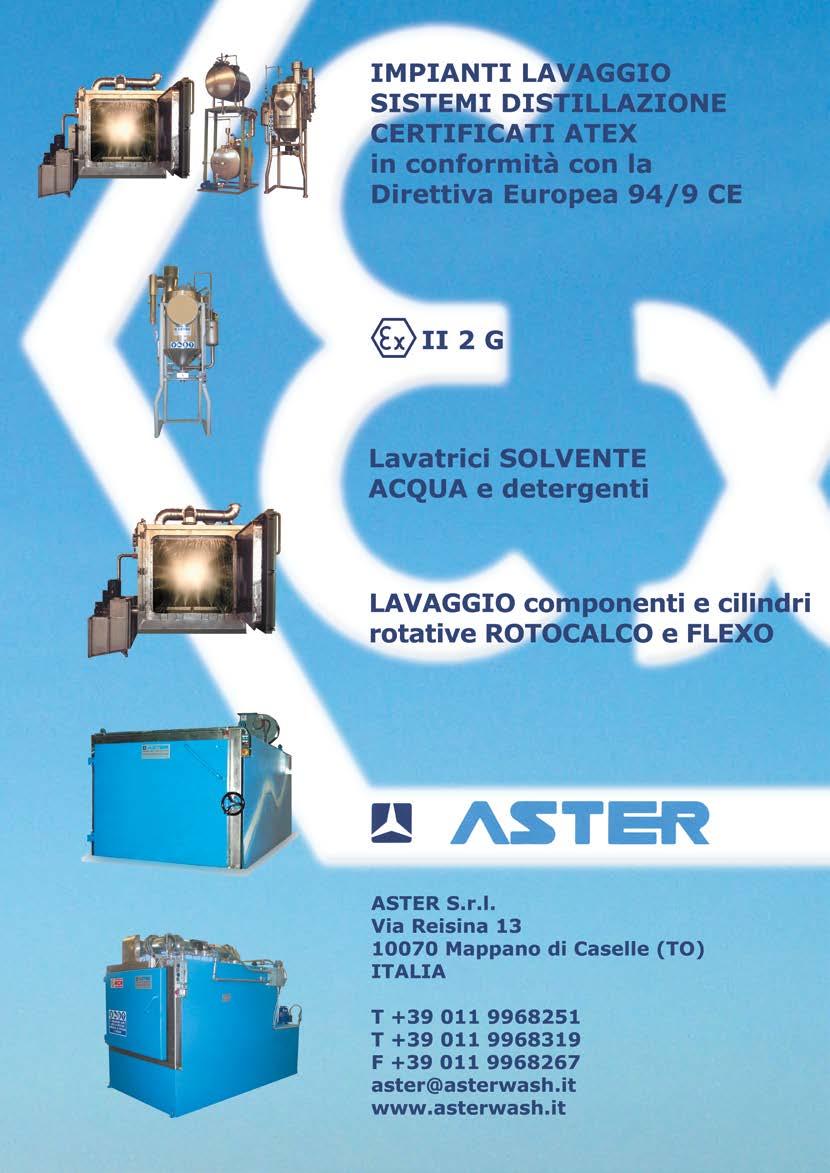


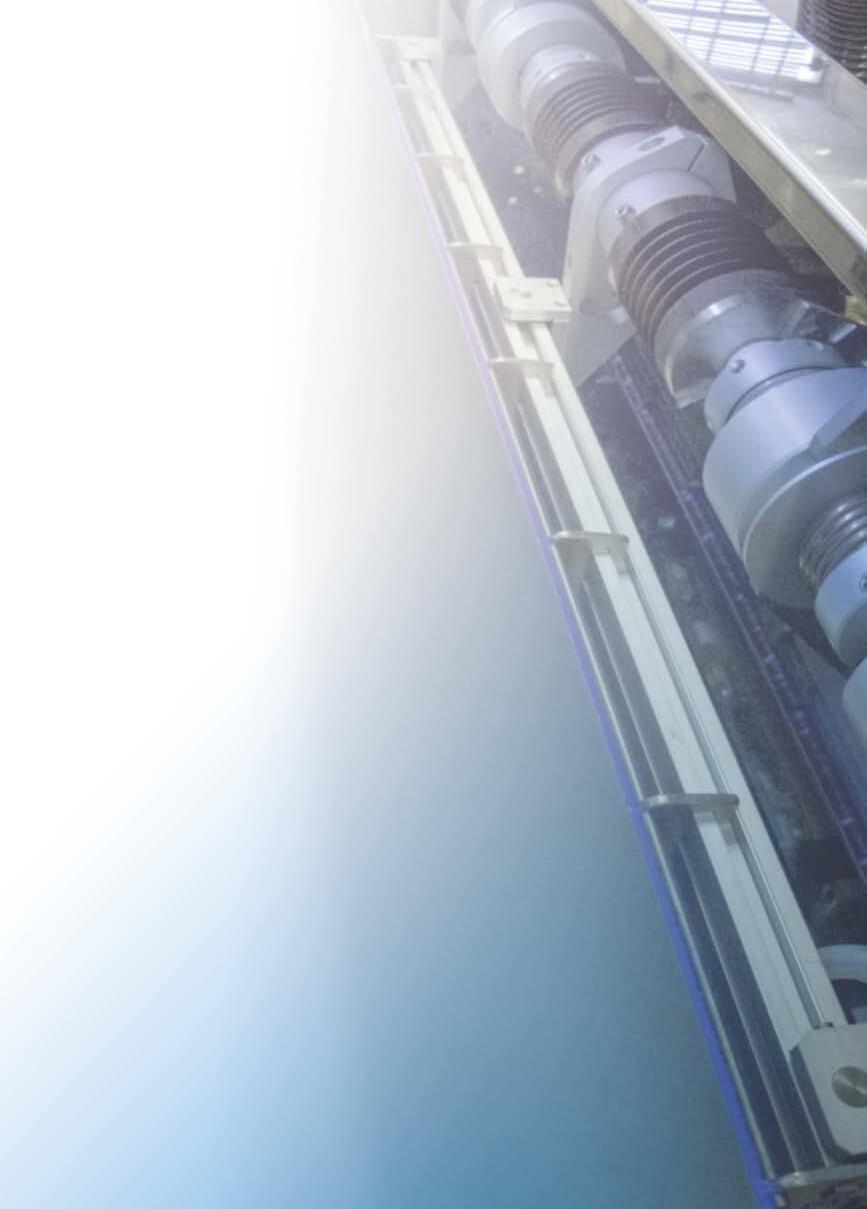
PER ABBONARSl
Nome e cognome:
Società:
Funzione all’interno della società:
Settore di attività della società:
Codice fiscale o partita Iva: Cod. Univoco FE:
Indirizzo:
Città:
Provincia: CAP: Stato:
Sito internet: e-mail:
Tel: Fax:
Abbonamento annuale per una rivista:
CONVERTER & CARTOTECNICA
CONVERTER FLESSIBILI CARTA E CARTONE
Italia € 40,00 - Estero € 90,00
Abbonamento annuale per due riviste:
CONVERTER & CARTOTECNICA + CONVERTER FLESSIBILI CARTA E CARTONE
Italia € 70,00 - Estero € 150,00
Bonifico bancario intestato a:
CIESSEGI EDITRICE SNC
CREDITO VALTELLINESE ag. 55
SAN DONATO MILANESE (MILANO)
IBAN: IT 88 I 05216 33711 000000002214
Compilare e spedire via mail a: flexo@converter.it (CIESSEGI EDITRICE)






